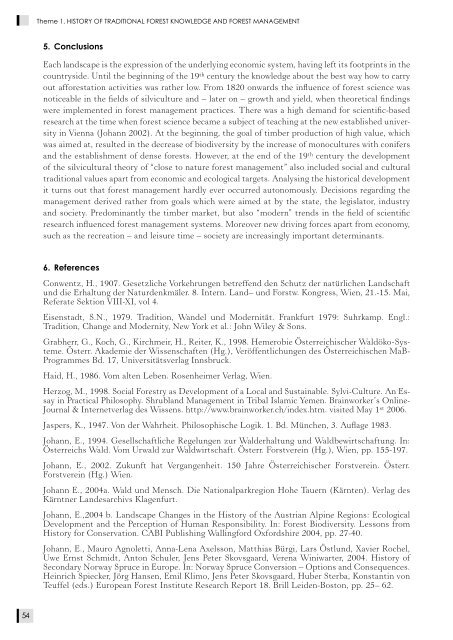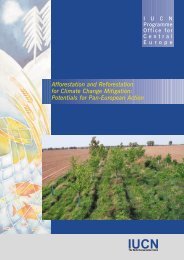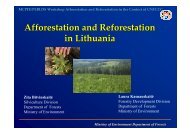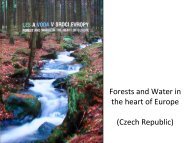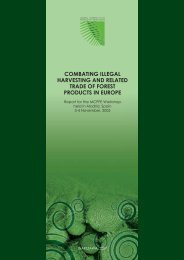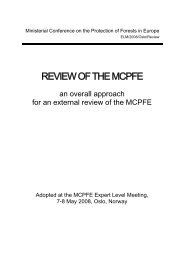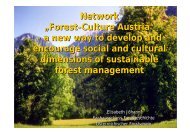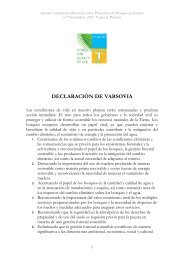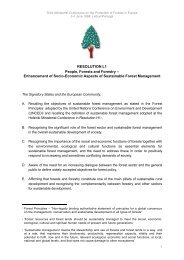Volume 1 - Forest Europe
Volume 1 - Forest Europe
Volume 1 - Forest Europe
You also want an ePaper? Increase the reach of your titles
YUMPU automatically turns print PDFs into web optimized ePapers that Google loves.
54<br />
Theme 1. HISTORY OF TRADITIONAL FOREST KNOWLEDGE AND FOREST MANAGEMENT<br />
5. Conclusions<br />
Each landscape is the expression of the underlying economic system, having left its footprints in the<br />
countryside. Until the beginning of the 19 th century the knowledge about the best way how to carry<br />
out afforestation activities was rather low. From 1820 onwards the infl uence of forest science was<br />
noticeable in the fi elds of silviculture and – later on – growth and yield, when theoretical fi ndings<br />
were implemented in forest management practices. There was a high demand for scientifi c-based<br />
research at the time when forest science became a subject of teaching at the new established university<br />
in Vienna (Johann 2002). At the beginning, the goal of timber production of high value, which<br />
was aimed at, resulted in the decrease of biodiversity by the increase of monocultures with conifers<br />
and the establishment of dense forests. However, at the end of the 19 th century the development<br />
of the silvicultural theory of “close to nature forest management” also included social and cultural<br />
traditional values apart from economic and ecological targets. Analysing the historical development<br />
it turns out that forest management hardly ever occurred autonomously. Decisions regarding the<br />
management derived rather from goals which were aimed at by the state, the legislator, industry<br />
and society. Predominantly the timber market, but also “modern” trends in the fi eld of scientifi c<br />
research infl uenced forest management systems. Moreover new driving forces apart from economy,<br />
such as the recreation – and leisure time – society are increasingly important determinants.<br />
6. References<br />
Conwentz, H., 1907. Gesetzliche Vorkehrungen betreffend den Schutz der natürlichen Landschaft<br />
und die Erhaltung der Naturdenkmäler. 8. Intern. Land– und Forstw. Kongress, Wien, 21.-15. Mai,<br />
Referate Sektion VIII-XI, vol 4.<br />
Eisenstadt, S.N., 1979. Tradition, Wandel und Modernität. Frankfurt 1979: Suhrkamp. Engl.:<br />
Tradition, Change and Modernity, New York et al.: John Wiley & Sons.<br />
Grabherr, G., Koch, G., Kirchmeir, H., Reiter, K., 1998. Hemerobie Österreichischer Waldöko-Systeme.<br />
Österr. Akademie der Wissenschaften (Hg.), Veröffentlichungen des Österreichischen MaB-<br />
Programmes Bd. 17, Universitätsverlag Innsbruck.<br />
Haid, H., 1986. Vom alten Leben. Rosenheimer Verlag, Wien.<br />
Herzog, M., 1998. Social <strong>Forest</strong>ry as Development of a Local and Sustainable. Sylvi-Culture. An Essay<br />
in Practical Philosophy. Shrubland Management in Tribal Islamic Yemen. Brainworker’s Online-<br />
Journal & Internetverlag des Wissens. http://www.brainworker.ch/index.htm. visited May 1st 2006.<br />
Jaspers, K., 1947. Von der Wahrheit. Philosophische Logik. 1. Bd. München, 3. Aufl age 1983.<br />
Johann, E., 1994. Gesellschaftliche Regelungen zur Walderhaltung und Waldbewirtschaftung. In:<br />
Österreichs Wald. Vom Urwald zur Waldwirtschaft. Österr. Forstverein (Hg.), Wien, pp. 155-197.<br />
Johann, E., 2002. Zukunft hat Vergangenheit. 150 Jahre Österreichischer Forstverein. Österr.<br />
Forstverein (Hg.) Wien.<br />
Johann E., 2004a. Wald und Mensch. Die Nationalparkregion Hohe Tauern (Kärnten). Verlag des<br />
Kärntner Landesarchivs Klagenfurt.<br />
Johann, E.,2004 b. Landscape Changes in the History of the Austrian Alpine Regions: Ecological<br />
Development and the Perception of Human Responsibility. In: <strong>Forest</strong> Biodiversity. Lessons from<br />
History for Conservation. CABI Publishing Wallingford Oxfordshire 2004, pp. 27-40.<br />
Johann, E., Mauro Agnoletti, Anna-Lena Axelsson, Matthias Bürgi, Lars Östlund, Xavier Rochel,<br />
Uwe Ernst Schmidt, Anton Schuler, Jens Peter Skovsgaard, Verena Winiwarter, 2004. History of<br />
Secondary Norway Spruce in <strong>Europe</strong>. In: Norway Spruce Conversion – Options and Consequences.<br />
Heinrich Spiecker, Jörg Hansen, Emil Klimo, Jens Peter Skovsgaard, Huber Sterba, Konstantin von<br />
Teuffel (eds.) <strong>Europe</strong>an <strong>Forest</strong> Institute Research Report 18. Brill Leiden-Boston, pp. 25– 62.


